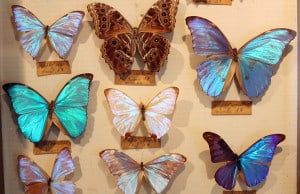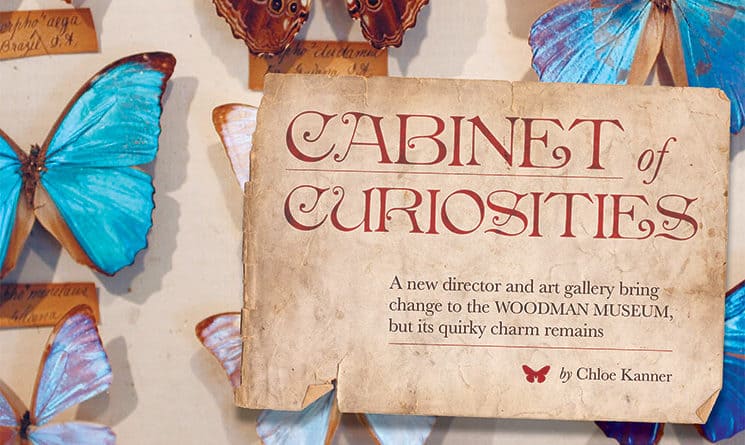but its quirky charm remains
When the Woodman Museum opened in 1916, its first curator lived on site, collecting winged things in a net at night, identifying and pinning them down for all to see in the day.
Some of Melville Smith’s original taxidermy remains in a cabinet of curiosities with scenic backgrounds painted by his wife. But, over time, the museum in Dover has accumulated countless objects of historical and cultural significance.
Next year, the Woodman Museum celebrates its 100th season. In many ways, it is still the same place that many remember visiting on school field trips, but things are changing.
This season, which began on April 1, the museum introduced its first-ever executive director, Wes LaFountain. He hopes to bring about financial stability and more visibility.
While the museum is full of history, LaFountain said, its future depends on keeping up with the times. Still, the quirky charm that attracted 3,200 visitors from 42 states and 17 countries last year isn’t going away.
“The polar bear is always going to be there,” he said.
Wes LaFountain, executive director of the Woodman Museum (photo courtesy of Thom Hindle)
The Woodman Museum’s collection maintains an early 20th-century organization, or lack thereof, with curio cabinets filled with all kinds of oddities and artifacts. The 10-foot-tall mounted polar bear, which was shot in the Arctic, is just around the corner from the saddle that President Abraham Lincoln rode on just a few weeks before his assassination. Dover residents donated both. In fact, almost everything in the museum was a gift.
There’s also one of the largest mineral collections in the Northeast, a four-legged chicken and a two-headed snake, prehistoric artifacts and fossils, collectable dolls, weapons and uniforms from major wars, the last cougar killed in New Hampshire, scouting memorabilia, a 27-pound lobster and a man-eating clam.
That’s only a fraction of what’s inside the Woodman House, which is one of the museum’s four buildings. Another is the Damm Garrison House, built from huge trees in 1675, for protection from Native Americans. It’s still filled with tools, utensils, and furniture from that time, including rope beds and looms.
Mike Day leads a tour of the Damm Garrison House, built in 1675.
Downstairs in the Hale House, there are 40 glass cases with hundreds of antiques relating to the area. And upstairs, there’s period furniture and fine art, including a desk used by Dover’s first mayor.
“I defy someone to come in and not find something and go, ‘Wow,’” said LaFountain.
For him, it was the iridescent blue butterflies in one of the display cases. “That’s when I knew I had to work here,” he said.
New direction
In just the past few years, the museum’s board of trustees has increased from three to seven members. Its first female member, Donna Ciotti, joined in December.
After 15 years as a trustee, Thom Hindle stepped down in 2013 and became the second-ever curator of the museum. He plans to retire next year, though he may continue to lead tours as a volunteer.
“My plan at the moment is to pass the keys,” Hindle said. “Another generation with fresh ideas and hopefully the same passion will take the museum into the next 100 years.”
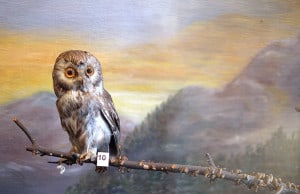
Hindle has been an integral part of the museum for about 30 years and knows the story behind every piece in it, from the mastodon tooth that was wrapped in dishcloth when he received it to the Boy Scout uniform that he used to wear.
“He has saved this place almost single-handedly,” LaFountain said.
The new executive director will cover the administration duties of the nonprofit business, including finding creative ways to secure much-needed funding. He said he expects fundraising to take up about half his hours.
He also intends to work more with schools and other museums, handle ongoing facilities issues, and increase both visitor and volunteer numbers.
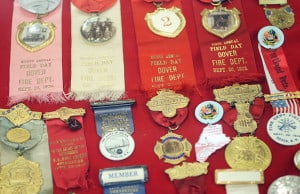
Anthony McManus, a museum trustee and Dover city councilor, said fundraising, publicity, and long-range planning had been a struggle for the volunteer board with a low budget.
LaFountain said the challenge is to change the static image of the museum and encourage people to return.
“We want people to pay attention to what we’ve got coming up, because it’s going to change,” he said.
Contemporary art
New this year, the Keefe House Gallery opens with a reception on Sunday, April 26, from noon to 3 p.m.
Ever since the Woodman Museum opened, its mission has been to promote the study of natural science, local history, and art.
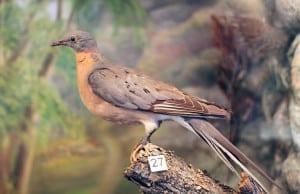
The science and history side is well established, but LaFountain said the museum hasn’t promoted visual arts to its potential. With 20 years of experience in the arts, including at the University of New Hampshire’s Museum of Art and the Portland Museum of Art, it is another one of his priorities.
The gallery will bring in contemporary, local art that will help connect the past to the present, LaFountain said.
The space is in three rooms of the renovated house from 1825, and there are some limitations on its creative use, but LaFountain said he plans to bring in work that pushes the boundaries.
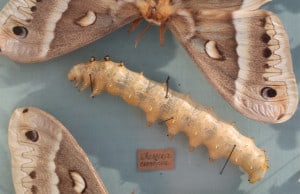
The inaugural exhibit, curated by Ross Bachelder, is titled “Voices from New England: Six Fine Artists Have Their Say.” It features work by Dover painter Tom Glover, Dover photographer Tom Lavoie, Rochester painter Sherry Palmer, Portsmouth fiber artist Diane Stradling, jewelry maker and encaustic artist Anne Strout, of Maine, and ceramic artist Don Williams, a UNH instructor.
As a fundraiser, there will be a raffle for one of Glover’s paintings, “Eagle with Spread Wings.” The winner will be announced when the exhibit closes on June 28.
The Woodman Museum is located at 182 Central Ave. in Dover. It’s open Wednesdays through Sundays, 10 a.m. to 5 p.m. Visit woodmanmuseum.org.
